Also, with +Alex Luyckx and +Mathew Marrash, who have both been asked similar questions, I have wondered this very thing myself.
Why do I shoot Large Format...
It's a complicated question, that is not easily answered. One reason I can think of, is quite simple. It is very relaxing. I enjoy shooting formats like 35mm, and 120.. but there is something that feels too fast about those formats. In a "never stop, never slow-down" world, I like the fact that there's something that cannot be done quickly.
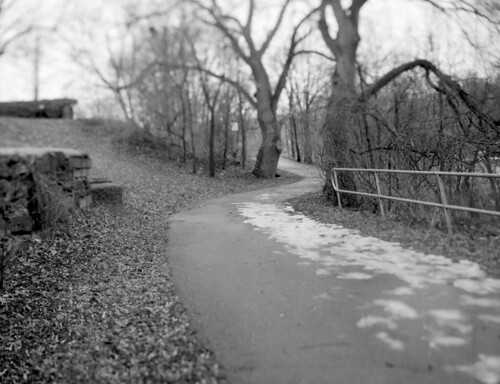 |
| "Winding" - Shanghai GP3 |
When I find myself looking for something far more relaxing and enjoyable than pointing a camera at a subject, and releasing the shutter without much though, I turn to my 4x5. Sure, I wander around with a massive Monorail, but there is something about these amazing cameras. They have immense capability.
The incredible amounts of movement on them, such as swing, tilt, shift, rise or fall, it gives a whole new dimension to the photo.
Take the image above. I'm able to keep the path in focus, while throwing other areas, such as the trees at the top of the image, out of focus, keeping your eyes centered on the path moving through the image.
Plus you can take a single film, and change your entire Metering Index for each shot. A 400 speed film can be 100, or even 800, giving different looks without ever changing your film. Just change your developing.
The incredible amounts of movement on them, such as swing, tilt, shift, rise or fall, it gives a whole new dimension to the photo.
Take the image above. I'm able to keep the path in focus, while throwing other areas, such as the trees at the top of the image, out of focus, keeping your eyes centered on the path moving through the image.
Plus you can take a single film, and change your entire Metering Index for each shot. A 400 speed film can be 100, or even 800, giving different looks without ever changing your film. Just change your developing.
 |
| "Oakville Lighthouse" - Fuji Provia 100F |
When you shoot colour, it takes on a whole different dimension. The detail begins to pop right out.
Colour takes on a whole new depth, and the clarity is unobtainable through any other means. Sure, it's only 4x5, but if you take a look at a regular printed photograph that you get from your Local Walmart, from a digital or 35mm print, you'll notice that the print dimensions are 4x6.
Now imagine a negative, or a transparency, that is basically taken on a sheet of film that is just 1" narrower
than the 4x6 print.
To this day, I still remember the very first time I got my hands on my 4x5 Monorail. Browsing the Kijiji website, I just so happened upon someone who was selling a Calumet CC400 with lensboard, case, 5 film holders, a pack of Fuji Provia 100F, and some other various stuff for a very inexpensive price.
All I needed was a lens, and I was ready to go!
So I popped onto that great auction site and got myself a Schneider-Kreuznach Symmar-S 210mm ƒ/5.6 Linhof lens for a price that I have never found again.
After I got the lens I designed, and made, my own lensboard. Painting the front Red, it really made it stand out. The lensboard takes in the "Calumet" red dot logo and blends it seamlessly with the surrounding Bluish-Gray finish of the rest of the camera.
It really looks quite sharp! Those that have seen the lensboard always remark at how lovely it looks.
The next lens I picked up was an old Kodak Ektar 127mm ƒ/4.7 Wide-Angle lens, commonly found on a Speed Graphic, such as what +Alex Luyckx has. It has such a wide image circle, that I think it'll even cover 5x7 film! It gives me movements on 4x5, and like many Kodak lenses, is incredibly sharp.
 |
| "Rundown" - EFKE IR820C w/Red Filter (Kodak Ektar 127mm) |
Lets look at it a different way. Why not shoot large format? Well, simple. The gear is heavy, cumbersome, expensive, and not easy to transport.
There are film holders, different lenses and boards, big heavy tripods, and enough movements to make your head spin.
But at the same time, when you are shooting a 35mm camera, or even that dSLR, you have a very limited perspective to think of. Where, I find, Large Format lets you take a whole different perspective when shooting.
You can shoot at an angle, and by adjusting your lens angle you can get straight lines and correct perspectives.
Plus, you slow down.
In a world where the digital camera can fire off 30 frames in a few seconds, the large format camera lets you stop, relax, and focus.
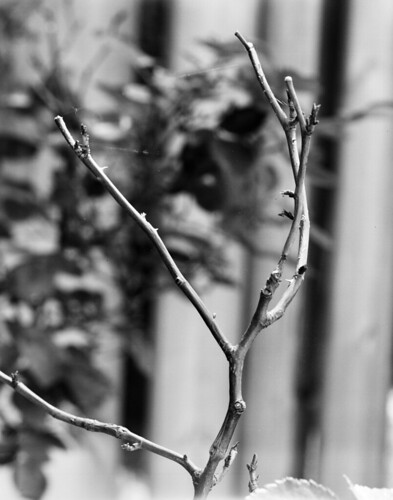 |
| "Spidersilk" - Fuji Provia 100F (Schneider-Kreuznach 210mm) |
Then you have to take a light reading. Well, when I took this, the sun was blasting down through the sky and blowing some parts of the image out. I was shooting a transparency after all, and wanted some of that powerful light to be behind some clouds. So I waited.... and waited... and waited....
After what seemed an eternity (was just short of two hours) I found the sunlight starting to wane.. then finally that harsh glaring light softened down.
Quickly taking a ready, and factoring in the bellows draw, I dialed in the settings on my lens, and the shutter.
Loading the film holder, drawing out the darkslide, then releasing the shutter, I knew I had the image I was after.
It was then that disaster struck. I forgot to label the holder properly, or note it in my book what was loaded.
So I ended up with this film being loaded into the tank along with many other B&W sheets to be processed in HC-110 Dil. H.
Sure enough, however, the image is nothing less than amazing. Super smooth, and incredibly well toned! I couldn't have gotten a better image if I tried.
It almost feels like it just works better in B&W than it ever could in colour.
My wife complains at times when I take the 4x5 our on a walk. "Why are you taking that thing for?? It's so big and heavy, and takes you forever to take a single photo!"
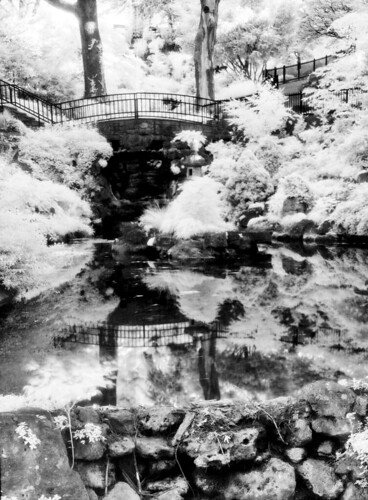 |
| "IR Garden" - EFKE IR 820C Hoya R72 Filter |
The image in my mind was perfect...
I lined it up in the camera, stopped down the lens, and just envisioned it.
Metering the shot as best as I could, I got the shutter ready and released it....
Tick... tick.... tick... tick.... 45 seconds ticked by....... then finally 90 seconds was reached, which was right on the money for what I metered for, and I closed the shutter....
I knew instantly that i had exactly what I was after...
Sure enough, the image, when I got the film developed, popped out and stared at me. The negative was just beautiful!
My very first IR image had been captured.. Unlike many others who shot their first IR on 35mm or even 120.. I did it on 4x5! And I was absolutely in love with IR! So much so that I bought a roll of Efke IR 820C in 35mm... It makes you slow down as well, shooting IR.
Then there is the old lenses that you find on old Kodak Folders, or the old Rapid Rectilinear lenses, or even Achromatic lenses.
These are dual element lenses that are either cemented together (Achromatic) or separated by a pocket of air (Rectilinear). The difference is that the Rectilinear lenses are actually convertible. Remove one of the elements and you can get a Telephoto effect, or a Wide-Angle effect. Most often it's a "TELEPHOTO" effect.
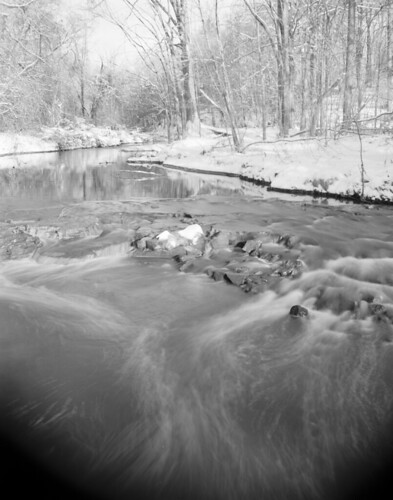 |
| "Running" - Ilford FP4+ (Kodak Rapid Rectilinear) |
And I can tell you right now, that was the best choice I could have made for these old cameras! The camera is just a light tight box, but if I can't use it, why let the lens, which is a beautiful piece of workmanship, go to waste?
So I did some testing. One of those tests was with some Ilford FP4+ and the lens during the winter.
Visiting one of my old haunts, the Trethewey Wetlands, I took a photo of the serene and glass-like Black Creek river.
What a beautiful site! I knew that as soon as I closed the shutter I had the image that would make me remember about why I shoot 4x5 film. Why large format is so special to me... and why I could never give it up....
Sure enough, this image has made its way onto my wall in the size of 11x14, but it doesn't even begin to do it justice. It needs to be bigger.... 16x20? Probably even bigger... It just had to be bigger! It has so much immense detail, and has such a feeling of serenity and peacfulness....... An image that can probably spend the next many years being reprinted over and over again..
But finally.... What I dare to dream of doing with my big camera... Shoot portraits..
 |
| "Mother and Daughter" Fomapan 400 (Schneider-Kreuznach 210mm) |
This is one of them. Sure, it's not the best for that "Candid" moment, but sometime the stars align, and you are able to capture that moment, just by being there, and being ready.
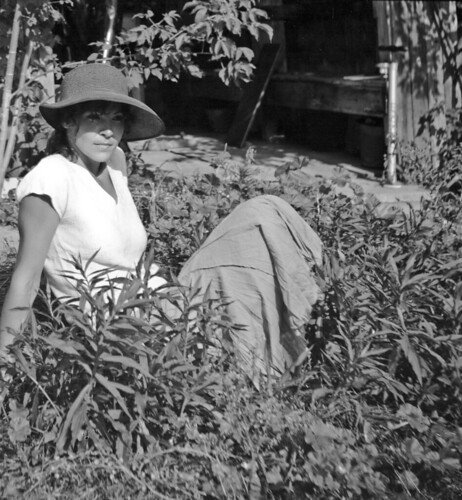 |
| "In The Field" - EFKE IR820C (Baush & Lomb Rapid Rectilinear) No Filter |
Then focus, and pay attention to your surroundings, the light, the position of your subject. How the background portrays with your subject, and ultimately, what the photo means to you. Does it tell a proper story?
Even when you shoot a digital format camera, you can easily just slow down, and relax. Take a breather and visualize the image before you before you even take the photo...
It'll materialize in your head, and when it does, then release the shutter.
You'll be much happier when you do..
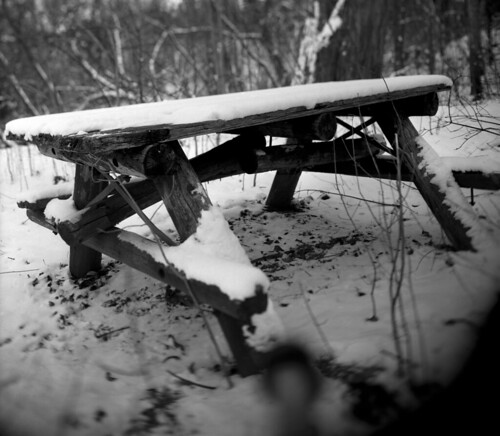 |
| "Ghostly Sitting" - Shanghai GP3 (Carl Zeiss Jena 105mm) |
I was so close, but again, the shot eluded me.
Sadly, this bench is no longer in this location, but has been moved... Now the image I must visualize again...
And hopefully one day, with the right equipment, I'll get the image I was after...
So why do I shoot Large Format Film?
The simplest answer is this...
Because it lets me imagine a world that perhaps doesn't exist. A simpler world, where time slows down, or even stands still... even if it's just for a moment...
Until next time... Keep those shutters firing!
Great post and some great pics, Mike. "Running" is a cracker. I haven't picked up my Speed Graphic for a few months but reading this makes me want to do so which is always a good measure of a post.
ReplyDeleteThanks Bruce! I have received many praises on "Running" and am quite proud of it myself.
DeleteSomething about that old Kodak Rectilinear lens.....
I'm glad it's giving you inspiration to get that old Speed Graphic out and start shooting with it.
They are immense fun! Check out Alex Luyckx's blog. He shoots a fair amount of 4x5 as well!
Thank you for reading, and for the great comment!
This was fantastic, Mike! And I wholeheartedly agree with you. I miss having all the movements on my 8x10 though. Especially after seeing that Path shot. DANG!
ReplyDeleteDang you, now I'm going to have to figure out a way to afford a MF camera. I was able to resist those tempting thoughts in my head up until now...
ReplyDelete